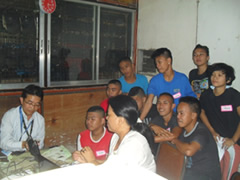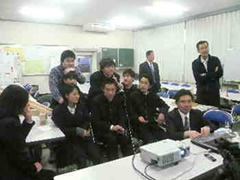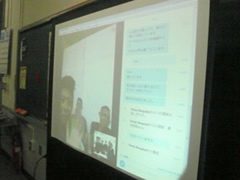Project News
2015-01-28
Subangdaku TVS bridges Japanese school
∗ Through "Training in Japan" conducted by the Project in October 2014, Subangdaku Technical Vocational School (STVS), one of pilot schools, started an exchange program with Chiba Prefectural Ichikawa Technical High School in Japan. STVS's teachers reports you about their activity.
With the advent of technology, it's getting easier to be connected to the world thus making globalization a trending issue inside the academe. Students are trained to explore, to discover and to create things that would somehow lead them to the global world. This is an aspiring goal of Subangdaku Technical Vocational School (STVS), to widen the students' opportunities to become competitive in the global arena. The school's effort to enhance the students' skills especially in Metalwork's needs support specifically in the communication aspect. This is the very reason that the teleconferencing of STVS in the Philippines and Ichikawa Technical High School in Japan was conceptualized. This is collective efforts of both schools which aims to give an opportunity to Grade XI Senior High School students experience an actual interaction through SKYPE.
The teleconferencing with the Ichikawa Technical High School students last January 28, 2015 was really an interesting activity. STVS students were very much excited and they really had prepared themselves for the said activity. It was participated by the Grade XI students, observed by the principal, Mrs. Myrna G. Yu, witnessed by Mr. Hirose of NEC Telecom Software Philippines, Inc., and facilitated by the two STVS teachers, Mrs. Niña Socorro B. Naces, an English teacher and Mr. Randy C. Mangubat, a Technical Vocational Education (TVE) teacher.
At first, fluctuating internet connection destructed the activity. We were not able to connect to SKYPE on scheduled time. However, after an hour of fixing the internet connections the interaction started. The first observation of STVS students was that Ichikawa Technical High School students were really very formal because they were wearing coat and tie. The STVS students were ashamed yet they tried to recover by being so friendly. Second, the STVS students noticed that Japanese students have different accent in speaking English Language. Third, STVS students discovered that they have longer time in TVE specialization compare to Ichikawa Technical High School because STVS has 10 hours a week while in Ichikawa Technical High school has 5 or 6 hours a week only (cf. Besides 5-6 hour practical training, there are 6 hour lectures per week for TVE specialization in Ichikawa Technical High School.) Fourth, STVS students learned that Ichikawa Technical High School offers more TVE specializations to the Senior High School than STVS because we have only three specializations. Finally, both schools have almost the same academic subjects like Math, Science, Physical Education, and others except Language subjects.
The online meeting breaks the barriers of schools in Japan and the Philippines when it comes to distance, language and cultures. It proves that communication can bridge the two schools which have the same goal and vision. The said teleconferencing is to be continued by the month of June or July, 2015.
By:
Niña Socorro B. Naces & Randy C. Mangubat
Ms Niña Socorro B. Naces is an English teacher, while Mr. Randy C. Mangubat, a Technical Vocational Education (TVE) teacher of Subangdaku Technical Vocational School, Mandaue City, Region XII.
 Students at STVS during the program (provided by STVS)
Students at STVS during the program (provided by STVS)
 Students at Ichikawa Technical High School during the program (provided by Ichikawa Technical High School)
Students at Ichikawa Technical High School during the program (provided by Ichikawa Technical High School)
 Teleconferencing through Skype
(provided by Ichikawa Technical High School)
Teleconferencing through Skype
(provided by Ichikawa Technical High School)
- About JICA
- News & Features
- Countries & Regions
- Our Work
- Thematic Issues
- Types of Assistance
- Partnerships with Other Development Partners
- Climate Change / Environmental and Social Considerations
- Evaluations
- Compliance and Anti-corruption
- Science and Technology Cooperation on Global Issues
- Research
- JICA Development Studies Program / JICA Chair
- Support for the Acceptance of Foreign HRs / Multicultural and Inclusive Community
- Publications
- Investor Relations
